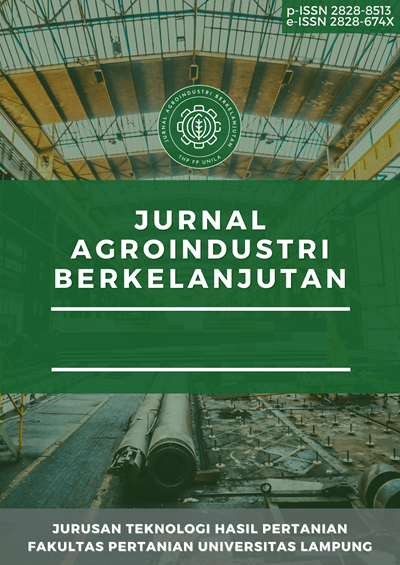PEMANFAATAN KULIT BUAH NAGA MERAH (Hylocereus polyrhizus) SEBAGAI PENSTABIL ES KRIM SUSU KAMBING ETAWA UTILIZATION OF RED DRAGON FRUIT (Hylocereus polyrhizus) SKIN AS A STABILIZER FOR ETAWA GOAT’S MILK ICE CREAM
DOI:
https://doi.org/10.23960/jab.v3i1.8852 Abstract View: 579
Abstract View: 579
Abstract
Red dragon fruit skin can be used as an additional ingredient in food. Red dragon fruit skin contains 10.80% pectin. The pectin content in the skin of red dragon fruit can be used as a stabilizer, one of which is an ice cream stabilizer. The aim of this research is to determine the effect of adding red dragon fruit peel flour as an ice cream stabilizer to produce ice cream with the best physical and sensory properties. The research was conducted using a Complete Randomized Block Design (RAKL) with a single factor consisting of 5 levels, namely the concentration of added red dragon fruit peel flour, namely 0.5%, 1%, 1.5%, 2%, and 2.5% and 4 repetition. As a control, 0.5% gelatin was used. The addition of red dragon fruit peel flour as an ice cream stabilizer has a significant effect on the taste, color, aroma, texture, overall acceptability, overrun, melting speed and stability of the ice cream emulsion. The addition of 1% red dragon fruit peel flour was the best treatment with a score for aroma of 2.79 (no prengus smell), texture of 3.15 (soft), color of 3.02 (liked), taste of 3.23 (liked) , overall acceptance of 3.27 (likes), overrun value of 69.69%, emulsion stability of 85.35 and melting speed of 53.83 minutes. Ice cream with the addition of dragon fruit peel flour contains 56.65% water content, 1.29% ash content, 6.32% fat, 4.96% protein and 30.78% carbohydrates.
Downloads
References
AOAC. 2016. Official Methods of Analysis of the Association of Official Analytical Chemistry Intrnational 20th Edition. Arlington: AOAC Inc.
Aristya, A.L., Legowo, A.M., Al-Baari, A.N. 2013. Karakteristik fisik, kimia, dan
mikrobiologis kefir susu kambing dengan penambahan jenis dan konsentrasi gula yang berbeda. Jurnal Aplikasi Teknologi Pangan, 2(3), Hal. 139-143.
Badan Standarisasi Nasional. 2018. SNI 01-3713-2018. Es Krim. Jakarta.
Boycheva S, Dimitriv T, Naydenova N, Mihaylova G, 2011. Quality characteristics of Yoghurt from goat’s milk, supplemented with fruit juice. Czech J Food Sci. 29:24-30.
Darma, G. S., Puspitasari, D., dan Noerhartati, E. 2013. “Pembuatan Es Krim Jagung Manis Kajian Jenis Zat Penstabil, Kosentrasi Non Dairy Cream Serta Aspek Kelayakan Finansial”. Jurnal Reka Agroindustri: Vol. I No. 1.
Goff, H. Doughlas dan Hartel, Richard W. 2013. Ice Cream Seventh Edition. Springer Science plus Bussines Media. New York. 462 hlm.
Hartayanie, L., Adriani, M., dan Lindayani. 2014. Karakteristik Emulsi Santan Dan Minyak Kedelai Yang Ditambah Gum Arab dan Sukrosa Ester. Jurnal Teknologi Dan Industri Pangan, 25(2), 152–157.
Paz, N. F., De Oliveira, E. G., De Kairuz, M. S. N., And Ramón, A. N. 2014. Characterization Of Goat Milk And Potentially Symbiotic Non-Fat Yogurt. Food Science And Technology 34(3): 629-635. ISSN 0101-2061.
Roland, A.M., L. G. Phillips and K.J. Boor. 1999. Effect of Fat Content On The Sensory Properties, Melting, Colour And Hardness of Ice Cream. J. Dairy Sci. 82: 32-38.
Sepryadi, T. 2015. Pengaruh Pemakaian Kulit Buah Naga Merah Terhadap Kualitas Kue Ku. (Skripsi). Jurusan Kesejahteraan Keluarga. Fakultas Teknik. Universitas Negeri Padang. 11 hlm
Winarno, F. G. 2014. Kimia Pangan dan Gizi. Gramedia Pustaka Utama. Jakarta.84-88 hlm.
Yuslianti, E. R. 2018. Pengantar Radikal Bebas dan Antioksidan. Deepublish. Yogyakarta. 109 hlm.
Zhang, Hua, Jianle Chen, Junhui Li, Chaoyang Wei, Xingqian Ye, John Shi, dan Shiguo Chen. 2018. Pectin from Citrus Canning Wastewater as Potential Fat Replacer in Ice Cream. Molecules 23 (4): 1–11.

